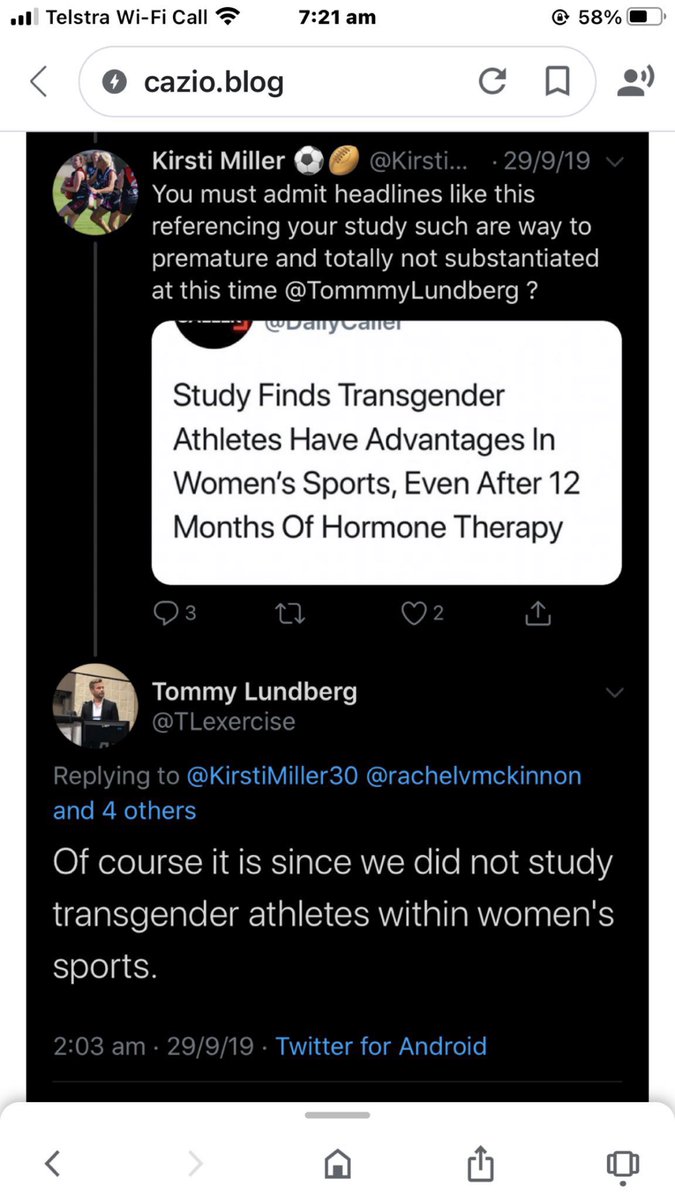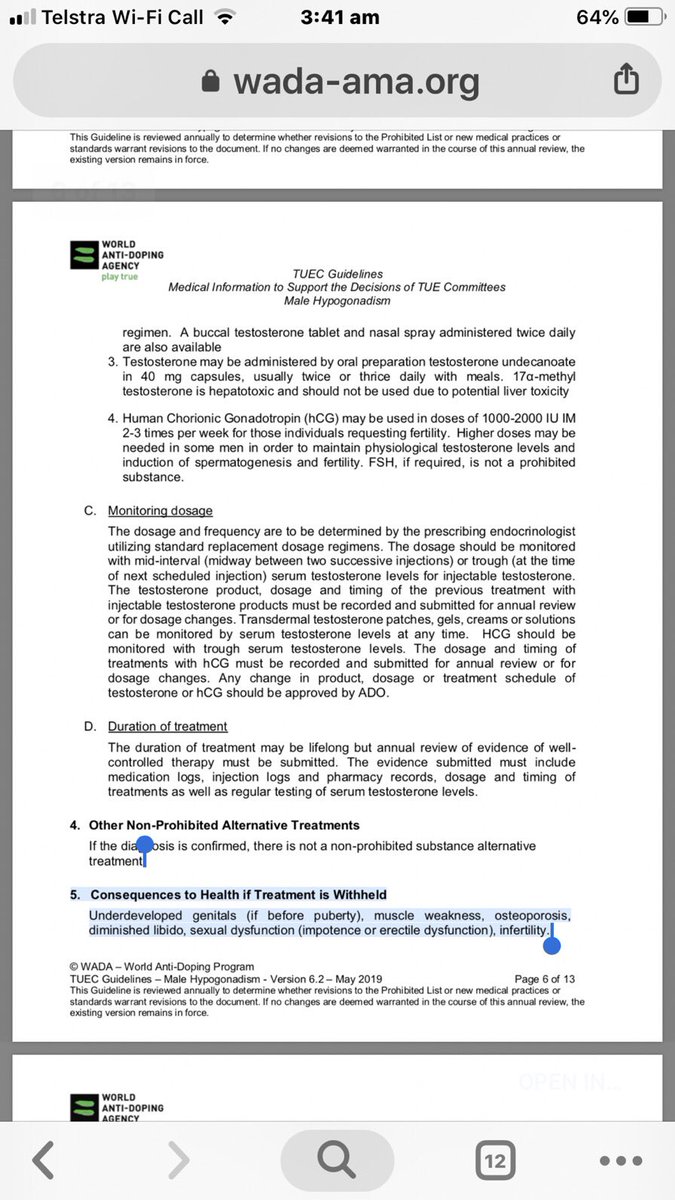
@KatyMontgomerie @Scienceofsport @Hazunki @EggAccount1648 @FondOfBeetles Given the scientific research on trans women (especially in sport) is incredibly limited, even if the view of current science presented by the WR Working Group’s policy represents the best consensus view that could exist, the accuracy of this consensus view is far from guaranteed
@KatyMontgomerie @Scienceofsport @Hazunki @EggAccount1648 @FondOfBeetles The WR guidelines developed by Tucker & co justify the ban on every single trans woman playing women’s contact rugby on two grounds: firstly, that the risk of injury is too great; secondly, that there is a retention of meaningful performance advantages to
@KatyMontgomerie @Scienceofsport @Hazunki @EggAccount1648 @FondOfBeetles trans women rugby players compared to cis women rugby players following what is currently considered an acceptable period of appropriate testosterone suppression. (Tucker & co made this assumption without testing a single trans rugby player not one).
@KatyMontgomerie @Scienceofsport @Hazunki @EggAccount1648 @FondOfBeetles Both an unfair competition argument and a safety one.
I will deal with each in turn. Risk of injury
The draft guidelines discuss modelling of injury risk using anthropometric data. This data has apparently been used in ‘standard biomechanical models’
I will deal with each in turn. Risk of injury
The draft guidelines discuss modelling of injury risk using anthropometric data. This data has apparently been used in ‘standard biomechanical models’
@KatyMontgomerie @Scienceofsport @Hazunki @EggAccount1648 @FondOfBeetles (guideline at p.8) to produce the data visualisations present in Figure 2 (guideline at p.9).
@KatyMontgomerie @Scienceofsport @Hazunki @EggAccount1648 @FondOfBeetles Without going into the details, it seems abundantly clear that disparity in body mass between the tackling player and the ball carrier is the parameter which drives these models, and this indeed is reflected by the draft guidance document itself which states:
@KatyMontgomerie @Scienceofsport @Hazunki @EggAccount1648 @FondOfBeetles ‘The magnitude of the known risk factors are thus predicted by the size of the disparity in mass between the players involved in the tackle’ (guideline at p.9).
@KatyMontgomerie @Scienceofsport @Hazunki @EggAccount1648 @FondOfBeetles Therefore, if there is no disparity in the body mass of the players involved in the tackle (or potentially where the cis woman ball carrier is physically larger than a trans woman tackling her), there is no obvious justification for believing that such a player would produce
@KatyMontgomerie @Scienceofsport @Hazunki @EggAccount1648 @FondOfBeetles the basis of the “disproportionate” risk of injury (i.e. of the “at least 20%-30% smallest possible risk increase” modelled in regards to “typical” players in the guidance) towards their opponent.
@KatyMontgomerie @Scienceofsport @Hazunki @EggAccount1648 @FondOfBeetles Although such a hypothetical player may not be “typical” (as the guidance has it), in terms of biological variation this is irrelevant: it is far from impossible that globally such trans women are out there and currently do or would like to play rugby.
@KatyMontgomerie @Scienceofsport @Hazunki @EggAccount1648 @FondOfBeetles WR would be banning them from playing based on physical characteristics that they, themselves, demonstrably do not possess, nor - if this “advantage” was meant to have been “baked in” during a puberty they have already undergone - could they possibly possess.
@KatyMontgomerie @Scienceofsport @Hazunki @EggAccount1648 @FondOfBeetles Therefore: does a more reasonable, more proportionate response exist? Yes – such players could be allowed to play on an individual case by case basis.
@KatyMontgomerie @Scienceofsport @Hazunki @EggAccount1648 @FondOfBeetles So: does the evidence provided by the WR Working Group in relation to the risk of injury being too great justify the banning of every trans woman from playing women’s contact rugby? No. It does not.
@KatyMontgomerie @Scienceofsport @Hazunki @EggAccount1648 @FondOfBeetles Retention of meaningful performance advantages
In short, the second pincer of the WR Working Group’s argument underlying their proposed guideline which would entirely ban all transgender women from playing women’s rugby is that following what is currently considered an acceptable
In short, the second pincer of the WR Working Group’s argument underlying their proposed guideline which would entirely ban all transgender women from playing women’s rugby is that following what is currently considered an acceptable
@KatyMontgomerie @Scienceofsport @Hazunki @EggAccount1648 @FondOfBeetles period of testosterone suppression (1 year) to a level currently considered appropriate by the relevant international bodies (<5nmol/l), there is retention of meaningful performance advantages by trans women in comparison to cis women in relation to rugby.
@KatyMontgomerie @Scienceofsport @Hazunki @EggAccount1648 @FondOfBeetles The language here is clear: this is a perceived unfairness issue rather than a safety issue.
@KatyMontgomerie @Scienceofsport @Hazunki @EggAccount1648 @FondOfBeetles This second pincer largely derives from a literature review by Hilton & Lundberg (2020). This literature review was used prior to peer review and formal academic publication.
@KatyMontgomerie @Scienceofsport @Hazunki @EggAccount1648 @FondOfBeetles The argument about trans women’s supposed competitive advantage is exactly that: supposed. It isn’t measured. Even the oft-cited Wiik study (Wiik et al 2020) wasn’t on athletes and used an unreliable proxy for athletic performance. 

@KatyMontgomerie @Scienceofsport @Hazunki @EggAccount1648 @FondOfBeetles What can be said is about Wiik et al and the Hilton review is that it does not make use of rigorous systematic meta- analysis tools used by a broadly similar (though clinical health-focused paper), looking into a more limited set of physical anatomical parameters
@KatyMontgomerie @Scienceofsport @Hazunki @EggAccount1648 @FondOfBeetles which may be considered important drivers of performance advantages: Klaver et. al. (2018).
@KatyMontgomerie @Scienceofsport @Hazunki @EggAccount1648 @FondOfBeetles Both papers demonstrate modest decreases in the important parameter of lean body mass with 1 year of hormonal therapy.
@KatyMontgomerie @Scienceofsport @Hazunki @EggAccount1648 @FondOfBeetles However, the clinical health orientated paper finds that the ‘trend of continuing effects regarding all outcomes was seen in the second year of therapy’ (Klaver et. al. p.47).
@KatyMontgomerie @Scienceofsport @Hazunki @EggAccount1648 @FondOfBeetles This directly contradicts the ‘plateau’ (Hilton & Lundberg p.13) effect that Hilton & Lundberg assert occurs at 1 year, despite the fact the Hilton & Lundberg paper also discusses the cross-sectional study by
@KatyMontgomerie @Scienceofsport @Hazunki @EggAccount1648 @FondOfBeetles Lapauw et. al. (2018) wherein ‘mean treatment duration of 8 years substantially reduces muscle mass and strength in transgender women’ (Hilton & Lundberg p11).
@KatyMontgomerie @Scienceofsport @Hazunki @EggAccount1648 @FondOfBeetles Therefore: could it be that there may be a longer period of testosterone suppression that may be a more reasonable solution to the retention of meaningful performance advantages than a complete ban of every trans woman from playing women’s contact rugby?
@KatyMontgomerie @Scienceofsport @Hazunki @EggAccount1648 @FondOfBeetles Potentially yes, and Hilton & Lundberg’s paper does not provide strong evidence to the contrary.
@KatyMontgomerie @Scienceofsport @Hazunki @EggAccount1648 @FondOfBeetles This directly leads on to the question of what might be considered a “meaningful” reduction in performance advantage. The guidelines do not provide a metric by which this “meaningful”-ness could be assessed
@KatyMontgomerie @Scienceofsport @Hazunki @EggAccount1648 @FondOfBeetles (though suggests that the ‘5% - 10%’ (guideline at p.13) decreases in parameters described by Hilton & Lundberg are not enough).
@KatyMontgomerie @Scienceofsport @Hazunki @EggAccount1648 @FondOfBeetles Indeed, neither the guidelines, nor the Hilton & Lundberg paper give examples of how the relevant performance advantage might be decomposed into simpler components for the purpose of scientific testing in relation to rugby specifically.
@KatyMontgomerie @Scienceofsport @Hazunki @EggAccount1648 @FondOfBeetles This is unclear, and without clarity of what the “meaningful” performance advantage is supposed to be in relation to rugby, how could any transgender woman demonstrate that their transition has reduced it by a meaningful amount?
@KatyMontgomerie @Scienceofsport @Hazunki @EggAccount1648 @FondOfBeetles Furthermore, it is made abundantly clear in the Hilton & Lundberg paper - but not from the guidelines – that ‘the extent of musculoskeletal changes in athletic transgender women... is unknown’ (Hilton & Lundberg p.12)
@KatyMontgomerie @Scienceofsport @Hazunki @EggAccount1648 @FondOfBeetles and they are only able to speculate whether ‘transgender women with greater muscle mass at baseline may experience larger decreases in mass and strength than non-athletic transgender women’ (Hilton & Lundberg p.12) because such peer-reviewed scientific research does not yet exist
@KatyMontgomerie @Scienceofsport @Hazunki @EggAccount1648 @FondOfBeetles Hilton & Lundberg do comment that trans women ‘often have low baseline (pre- intervention) bone mineral density, attributed to low levels of physical activity, especially weight-bearing exercise’ (Hilton & Lundberg p.8).
@KatyMontgomerie @Scienceofsport @Hazunki @EggAccount1648 @FondOfBeetles For example, trans women have bone density lower than natal males, natal females, and FtMs, as a group, BEFORE hormone therapy even begins (sample=711, FAR larger than any of the studies Hilton uses)
asbmr.onlinelibrary.wiley.com/doi/full/10.10…
asbmr.onlinelibrary.wiley.com/doi/full/10.10…
@KatyMontgomerie @Scienceofsport @Hazunki @EggAccount1648 @FondOfBeetles Finally, Hilton & Lundberg do concede that ‘changes in strength measurements are not always correlated in magnitude to changes in muscle mass’ (Hilton & Lundberg p.12), and that other parameters may be important.
@KatyMontgomerie @Scienceofsport @Hazunki @EggAccount1648 @FondOfBeetles As it is not necessarily true that there is a straightforward correlation between muscle mass and strength measurements, and if we conceive of performance advantage in rugby as an emergent property of multiple different interacting parts, to demonstrate what the
@KatyMontgomerie @Scienceofsport @Hazunki @EggAccount1648 @FondOfBeetles performance advantage men have over women in rugby really requires thoughtful decomposition of what this would entail, and then rigorous testing to ensure trans women do not have this advantage.
This scientific study has never taken place.
This scientific study has never taken place.
@KatyMontgomerie @Scienceofsport @Hazunki @EggAccount1648 @FondOfBeetles Banning every trans woman from playing women’s rugby on the basis of risk outcomes of a group level aggregate of physical characteristics that any given individual belonging to this group may demonstrably not possess individually
@KatyMontgomerie @Scienceofsport @Hazunki @EggAccount1648 @FondOfBeetles cannot be considered reasonable, proportionate or justified. In relation to performance advantage: there is evidence that increasing the acceptable period of testosterone suppression may further reduce parameters thought to be associated with
@KatyMontgomerie @Scienceofsport @Hazunki @EggAccount1648 @FondOfBeetles “meaningful” performance advantage in trans women (which would clearly be more reasonable than banning all trans women),
@KatyMontgomerie @Scienceofsport @Hazunki @EggAccount1648 @FondOfBeetles there is currently no definitive threshold of what this “meaningful” reduction should be anyway, and finally there is no current scientific work demonstrating specifically what the performance advantages of men over women in rugby itself could be said to be composed of.
@KatyMontgomerie @Scienceofsport @Hazunki @EggAccount1648 @FondOfBeetles This means there is no current threshold of “meaningful” performance advantage reduction that any trans woman rugby player could satisfy. Therefore, trans women are placed in an uncomfortable double-bind: accused of performance advantage they cannot prove they do not possess.
@KatyMontgomerie @Scienceofsport @Hazunki @EggAccount1648 @FondOfBeetles This is before we consider the uncomfortable fact that none of the evidence presented by World Rugby involves empirical research of trans women rugby players actually playing rugby.
@KatyMontgomerie @Scienceofsport @Hazunki @EggAccount1648 @FondOfBeetles Despite all of this, transgender women are blanket excluded from playing elite Womens contact rugby.
End
End
• • •
Missing some Tweet in this thread? You can try to
force a refresh










